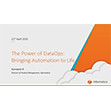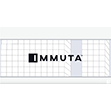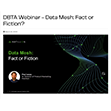
Bayesia on Numbers and Noms
Big data has many problems associated with it, from storing the vast amount of data companies collect to analyzing it and making it do work. However, according to Stefan Conrady, Managing Partner at Conrady Applied Science, and Dr. Lionel Jouffe, CEO of Bayesia, the bigger problem lies in quantifying qualitative data.
 “We think this is a very nice problem to have,” said Jouffe of the big data problem. “Much more serious problems exist on the opposite end of the spectrum, where there is not enough data. Unfortunately, all the advanced knowledge discovery algorithms fail in the absence of data.” Jouffe and Bayesia hope to formalize expert knowledge with BEKEE, or Bayesia Expert Knowledge Elicitation Environment. “Instead of going just from expert judgment to inference,” said Conrady during a webinar which demonstrated BEKEE’s capabilities “we would rather capture formally the knowledge experts have.”
“We think this is a very nice problem to have,” said Jouffe of the big data problem. “Much more serious problems exist on the opposite end of the spectrum, where there is not enough data. Unfortunately, all the advanced knowledge discovery algorithms fail in the absence of data.” Jouffe and Bayesia hope to formalize expert knowledge with BEKEE, or Bayesia Expert Knowledge Elicitation Environment. “Instead of going just from expert judgment to inference,” said Conrady during a webinar which demonstrated BEKEE’s capabilities “we would rather capture formally the knowledge experts have.”
For example, while a relational database could provide great insights based on highly quantitative data such as transactions and financial statements, it would not do so well analyzing wine preferences relative to specific meals.
Now of course, determining which wine goes with a given meal may not be a lucrative enterprise for those not involved in the high quality restaurant industry. Even then, those five-star restaurants should have sommeliers whose guesses should not differ too much from a crowd-sourced consensus. However, using wine as an example was beneficial in that most people, including those participating in the webinar have had at least some experience pairing wines with food.
This qualitative analysis can prove useful in determining a company’s internal efficiency. While taking a company-wide survey and compiling the results has its value, a collaborative effort among the “experts” of the company over a period of three days produces much more valuable insights, according to Jouffe. For example, a company can get together and determine which department brings the most to the table out of management, human resources, and sales. This collaboration is both facilitated and scored by BEKEE.
So what does this process do that a simple survey cannot? A great deal lies in what could not fit in a fifteen-minute demonstration. These “brainstorming sessions,” as Jouffe called them, are designed to last three days with most of the people in the same room. This allows for multiple rounds of testing and, more importantly, discussion.
Jouffe noted that while those biases cannot be stricken from their analysis, especially the crowd-based bias which is inherent in any long-term group brainstorming, awareness of those biases makes it possible to reduce their impact on the resulting data. Indeed, BEKEE notices if it appears crowd biases are affecting responses over time. According to Jouffe, BEKEE’s job is to build a probability distribution, not a consensus.
A clear example of that bias awareness process came about during the short demonstration. Jouffe asked which color, red or white, of wine went best with a non-poultry or fish meat dish topped with a spicy sauce. Of the six responders, five were European or American while the sixth was Indian. The five westerners picked red (with an average probability of 0.9) while the Indian picked white.
This cultural bias propagated itself again when Jouffe presented a poultry dish with a sweet sauce, except this time the westerners picked white while the Indian picked red.
Again, using wine preference was merely a simple method to understand and demonstrate what BEKEE can do. Ideally, these sessions would be conducted over multiple days in the same room.
Jouffe and Bayesia hope to deliver in the qualitative analysis world what big data platforms are delivering in the quantitative. They showed that, at least over fifteen minutes analyzing wine preferences, BEKEE is at least a step in the right direction.



























